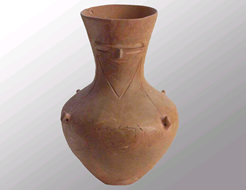|
||||||||||||||||||||||||||||||||
|
|
Museum of: Budapest | |||||||||||||||||||||||||||||||
| Name of the artefact: Double-faced vessel B | ||||||||||||||||||||||||||||||||
|
Neolithic Double-faced pot with "M" -shaped line
framing the face from Budapest, Békásmegyer |
||||||||||||||||||||||||||||||||
|
WHERE IS IT AND MAIN CHARACTERISTICS |
STATE |
|||||||||||||||||||||||||||||||
|
Department: |
Prehistoric Department |
Preservation: |
Very good | |||||||||||||||||||||||||||||
|
Inventory number: |
60.27.3 |
Restauration: |
Restored | |||||||||||||||||||||||||||||
|
Name of the artefact: |
Double-faced vessel B |
Completeness: |
Complete | |||||||||||||||||||||||||||||
|
Object type: |
Vessel/Anphora |
|||||||||||||||||||||||||||||||
|
Material: |
clay |
|||||||||||||||||||||||||||||||
|
Methof of manufacture: |
Hand made<< |
|||||||||||||||||||||||||||||||
|
Decoration type: |
Incision |
|||||||||||||||||||||||||||||||
|
Distinctive mark: |
Incised "M" -shaped line framing the face |
|||||||||||||||||||||||||||||||
|
DIMENSIONS |
PERIOD OF USE |
|||||||||||||||||||||||||||||||
|
Length (mm): |
- |
Epoque: |
Neolithic |
|||||||||||||||||||||||||||||
|
Heigth
(mm): |
375 mm |
Culture: |
Transdanubian Linear Pottery Culture |
|||||||||||||||||||||||||||||
|
Diameter
(mm): |
100-155 mm |
Period: |
Middle<< |
|||||||||||||||||||||||||||||
|
Width (mm): |
- |
Face: |
Zselíz |
|||||||||||||||||||||||||||||
|
Thickness (mm): |
- |
Absolute chronology: |
5200-5000/4900 BC |
|||||||||||||||||||||||||||||
|
Weight
(g): |
- |
|||||||||||||||||||||||||||||||
DISCOVERY |
||||||||||||||||||||||||||||||||
|
Date: |
1960 |
Country: |
Hungary |
|||||||||||||||||||||||||||||
|
District: |
- |
Town hall affiliation: |
Budapest |
|||||||||||||||||||||||||||||
|
Village: |
- |
Discovery findspot: |
Budapest III. district, Békásmegyer,
|
|||||||||||||||||||||||||||||
|
Condition of discovery: |
Archaeological excavation |
Discovery type: |
Pit |
|||||||||||||||||||||||||||||
|
ANALYSES – DETERMINATIONS |
FILLED IN BY |
|||||||||||||||||||||||||||||||
|
Type: |
- |
Name: |
Zsuzsanna M. Virág |
|||||||||||||||||||||||||||||
|
Laboratory: |
- |
Institution: |
Budapest History Museum |
|||||||||||||||||||||||||||||
|
No./Code: |
- |
Date: |
21/01/2006 |
|||||||||||||||||||||||||||||
|
DEEPENINGS |
||||||||||||||||||||||||||||||||
|
Morphology of the object: |
||||||||||||||||||||||||||||||||
|
The reconstructed flask-shaped vessel shows a strongly
stylized human shape. Two identically executed human faces can be seen
on the opposite sides of the funnel-shaped neck. Four knob ornaments,
interpreted as stylised hands, sit on the shoulder of the vessels,
adjusted to the faces. |
||||||||||||||||||||||||||||||||
|
Decoration: |
||||||||||||||||||||||||||||||||
|
The triangular faces located on the lower part of the
neck were framed with lines depressed in an “M” shape starting from the
knob ornaments on the shoulder. The nose and the eyebrows, depicted with
a continuous line, were marked with a plastic ornament, while the eyes
and the mouth were indicated with incised lines. |
||||||||||||||||||||||||||||||||
|
Inscription: |
||||||||||||||||||||||||||||||||
|
- |
||||||||||||||||||||||||||||||||
|
Analogies: |
||||||||||||||||||||||||||||||||
|
Face-pots appear in Transdanubia in the younger phases
of the TLP. The especially characteristic “M”-shaped incised motive that
frames the face was depicted in a similar manner from the southern part
of the Carpathian Basin to Central and Western Germany. Only the above
described item from Békásmegyer and a vessel from Biatorbágy could
completely be reconstructed from the flask-shaped vessels of the TLP.
They were evidently two-faced items. The two-faced vessels uncovered at
Vinča and in the Bucovaţ group in the Banat attest to the southern
contacts of the vessel. The closest analogues of the face-pots of the
younger TLP can be found in the Szakálhát culture of the Great Hungarian
Plain. The morphological similarities together with the M-shaped incised
pattern proved the mutual contacts that appeared in the field of
spiritual life as well. The contact zone of the two cultural complexes
was around Budapest, which can be supposed from the especially large
number of face-pots in the younger sites of the TLP in this region. |
||||||||||||||||||||||||||||||||
|
Interpretation: |
||||||||||||||||||||||||||||||||
|
Face-pots could be the paraphernalia of the cult life
linked with the assurance of fertility. Regarding the interpretation of
the “M”-shaped incised line, which appears as a part of the face and
which was prepared in an identical manner in a very wide sphere, various
suggestions have been made. In certain ideas the sign represents a
highly stylistic human shape, which being thus doubled, emphasises the
significance of the anthropomorphic feature that is more-or-less
expressed in the shape of the vessel. In other theories, the “M”-shaped
line framing the face was simply meant to stress the face and the neck. |
||||||||||||||||||||||||||||||||
|
Bibliography: |
||||||||||||||||||||||||||||||||
|
Kalicz, Nándor-Makkay, János: Gefässe mit
Gesichtsdarstellungen der Linienbandkeramik in Ungarn. In: Idole.
Prähistorische Keramiken aus Ungarn. Veröff. Naturhist. Mus. Wien 7,
1972. 9-15. Kalicz, Nándor: Figürliche Kunst und bemalte Keramik aus dem
Neolithikum Westungarns. Budapest, 1998; Raczky, Pál – Anders, Alexandra:
The internal relations of the Alföld Linear Pottery culture in Hungary
and the characteristics of human representation. In: Jerem, E. – Raczky,
P. (Hrsg.) Morgenrot der Kulturen. Frühe Etappen der Menscengeschichte
in Mittel- und Südosteuropa. (Festschrift für Nándor Kalicz zum 75.
Geburtstag) Budapest, 2003. 155-183; M. Virág, Zsuzsanna:
Anthropomorphic Vessels of Transdanubian Linear Pottery Culture. In: St.
Hiller-V. Nikolov (Hrsg.), Karanovo Band III. Beitrage zum Neolithikum
in Südosteuropa. Wien, 2000. 389-405. |
||||||||||||||||||||||||||||||||

